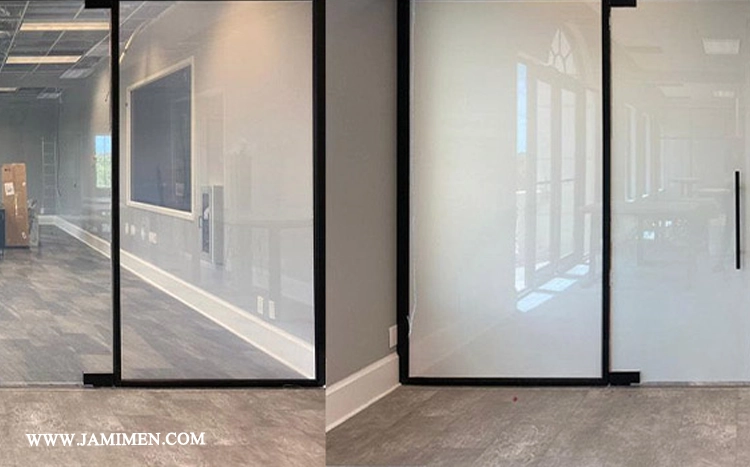All About Building Window and Door Glass
In today's world, glass is widely recognized as an essential element in the construction industry.

In today's world, glass is widely recognized as an essential element in the construction industry. This exceptional material has enhanced homes with its beauty, comfort, and safety features. Due to its diverse properties, architectural glass has become a primary construction method. Glass can establish a direct connection between the interior and the surrounding environment, allowing individuals to enjoy a happy and comfortable life illuminated by natural light. The proper selection and effective utilization of glass in construction not only creates an aesthetically pleasing environment but also contributes to insulation, safety, lighting, and resistance against impact and pressure.
Given these considerations, the utilization of glass in constructing doors and windows is a significant aspect that builders must prioritize during construction. In this regard, we will delve into the nature of architectural glass, and its distinctive features, and present various types of glass suitable for building doors and windows.
Please continue reading to explore further.
All About Building Window and Door Glass
Glass, as a crucial component of the construction industry, assumes a fundamental and indispensable role in enhancing the aesthetics and functionality of buildings. When it comes to building windows and doors, glass, with its amalgamation of diverse features, stands out as a primary material employed in the construction sector. From multiple perspectives, glass can contribute to the creation of beauty and serve as a finishing touch for both the exterior and interior designs of buildings.
Suitable Glass for Building Doors and Windows
In today's contemporary world, architects and designers employ their creativity and utilize modern design methods to craft distinct and innovative spaces by seamlessly integrating glass with other building materials. The incorporation of glass in building construction not only enhances the building's visual appeal and allure but also guarantees its functionality and efficiency.
Considering the diverse array of features offered by modern architectural glass, this remarkable product finds its application in numerous areas within a building. These include windows, building exteriors, elevators, balconies, partitions, and even bathrooms, underscoring the immense significance of glass in the construction industry.
Why Should Glass be Used in the Construction of Buildings?
As you're aware, glass stands as one of the primary building materials extensively employed in the construction industry today. However, the central query that arises is why glass is widely acknowledged as one of the finest raw materials in building construction.

Suitable Glass for Building Doors and Windows
The use of glass in the construction industry is driven by several key reasons:
- Adequate Lighting: Glass is favored as the top choice for window production due to its ability to absorb and introduce light into interior spaces, significantly improving the overall lighting environment.
- Weather Resistance: Glass exhibits robust resistance to weather changes, making it highly durable against elements such as rain, wind, and dryness. This resilience is of great importance in the construction industry.
- Rust Resistance: Unlike metallic materials, glass does not rust. It remains intact over time, resisting environmental impacts such as acids and bases, which is a crucial consideration in construction.
- Smooth and Washable Surface: The brilliance of glass enhances the attractiveness of buildings. Its smooth surface enables easy removal of dust, ensuring that it retains its shine.
Cleaning of Suitable Glass for Building Doors and Windows
- Recyclability: Glass is recyclable and can be processed without compromising its quality, making it an environmentally friendly material.
- Ultraviolet Ray Resistance: Glass can resist ultraviolet rays without undergoing color changes. This makes it an ideal choice for doors and windows, as it helps maintain the beauty and appearance of materials.
- Temperature Tolerance: Glass can withstand high temperatures, making it a suitable option for areas with significant temperature fluctuations.
Considering these factors, glass emerges as one of the top raw materials for building doors and windows. Consequently, builders across the industry incorporate glass in various parts of their structures.
What Features Should Building Window and Door Glass Have?
The diverse applications of glass in construction have resulted in the utilization of various glass types within the industry. In this context, it is crucial to understand the essential features that glass used in construction should possess:
- Architectural glass must be devoid of defects and flaws such as chipping, bending, and cracking.
- The glass thickness should maintain consistency throughout.
- Building window and door glass should demonstrate resistance to weather and atmospheric conditions, retaining its clarity over time.
- Scratches or cracks are unacceptable in architectural glass, and any defects or flaws should be identified and rectified during the production stages.
Types of Building Window and Door Glass
Glass has always been an alluring element in building design, capturing the attention of architects. This versatile material allows for the creation of distinctive and captivating architectural designs. The market offers a variety of glass types, each produced using different methods to cater to various building requirements.
The following are the main types of building window and door glass:
Float Glass:
Float glass is a primary type of glass used in the production of building doors and windows. It is offered in different thicknesses and can be further processed with protective layers and heat treatment to create other glass models. Float glass has less transparency compared to other types and is sometimes referred to as green glass.
Tempered Glass:
Tempered glass is a highly popular choice for architectural applications, particularly in commercial building doors. It is known for its enhanced strength and resistance. Tempered glass is designed to withstand breaking and high temperatures. In the event of breakage, it fractures into small pieces with polished edges, minimizing the risks associated with regular glass.

Tempered Glass
Laminated Glass:
Laminated glass consists of two or more layers of glass with a PVB (polyvinyl butyral) interlayer. It is used in locations that require high strength and safety. When broken, the glass remains intact due to the interlayer, preventing the dispersion of glass particles. Architects often favor laminated glass for its unique characteristics in building design.
Obscure Glass:
Obscure glass is a popular choice in buildings due to its ability to transmit light while maintaining privacy. This type of glass allows for the separation of spaces while providing adequate lighting, creating an illusion of larger living areas. In small and crowded spaces, Obscure glass reduces the sense of congestion compared to transparent glass. Satina glass is a common obscure glass variant used in modern interior spaces, featuring a uniformly frosted surface without clear transparent sections.
Double-Glazed Glass:
Double-glazed or multi-glazed glass is widely used in architecture due to its excellent sound and heat insulation properties. This type of glass consists of two glass panes with a vacuum or air-filled space between them. Double-glazed glass is highly effective in controlling sound transmission and heat transfer. Different combinations of glass, such as float, patterned, mirror, tempered, and laminated glass, can be used to meet specific environmental needs.

Double-Glazed Glass
Mirrored Glass:
The mirrored glass features a coating on its outer layer that optimally reflects light. These glasses help reduce heat gain within the building while efficiently transmitting light into the space. During the day, they act as mirrors, protecting the interior from outside view. However, at night, the reflective property reverses, allowing light from the interior to be observed from outside.
Colored Glass:
Colored glass finds extensive use in shop windows, exhibitions, and residential buildings. These glasses absorb a significant portion of light while illuminating the interior space in an appealing and varied range of colors. Colored glass adds diversity and attractiveness to the space, creating unique design effects.
Important Points About Architectural Glasses
After learning the types of architectural glasses, it is worth knowing that architectural glasses have a significant impact on energy efficiency and environmental aesthetics. Now, it’s worth paying attention to some important points:
- Opt for double or multi-glazed glass for windows as they provide superior sound and heat insulation. Prioritize this type of architectural glass during your selection process.
- When purchasing architectural glass, ensure that it is free from waves or distortions and that its transparency is consistent across the entire surface.
- If using double-glazed glass, verify that the sealing tapes and adhesive between the glass layers are properly applied. Conduct tests to confirm the presence of gas between the layers.
- Before installation, inspect the glass for any skewness, cracks, or chips.
- During transportation, use suitable vehicles and equipment to prevent damage to the glass. Store and handle the glass at the project site away from traffic areas to avoid any potential harm.
- After installation, ensure that screws and glass holding clamps are securely tightened.
- When using large glass panels in the facade, opt for tempered and laminated glass to minimize the risk of injuries in case of breakage.
- Choose tempered glass for areas where people frequently pass by to reduce the risk of injury in case of breakage.
By considering these tips, you can make informed decisions when selecting architectural glass, leading to improved building construction quality. Prioritize the careful selection of architectural glass for building doors and windows to achieve optimal results.
Purchasing Building Window and Door Glass from Jam Imen Company
One of the crucial considerations for builders when purchasing tempered glass for building doors and windows is selecting a reputable manufacturer. Jam Imen Co. is widely recognized as a leading manufacturer of tempered architectural and industrial glass, serving customers nationwide and exporting products to over 8 countries worldwide. This enables customers to confidently acquire their desired products from the company promptly. Leveraging top experts in the field, this esteemed manufacturer consistently meets the diverse needs of customers. Therefore, if you are in search of tempered glass for building doors and windows, Jam Imen Co. is an excellent choice.









